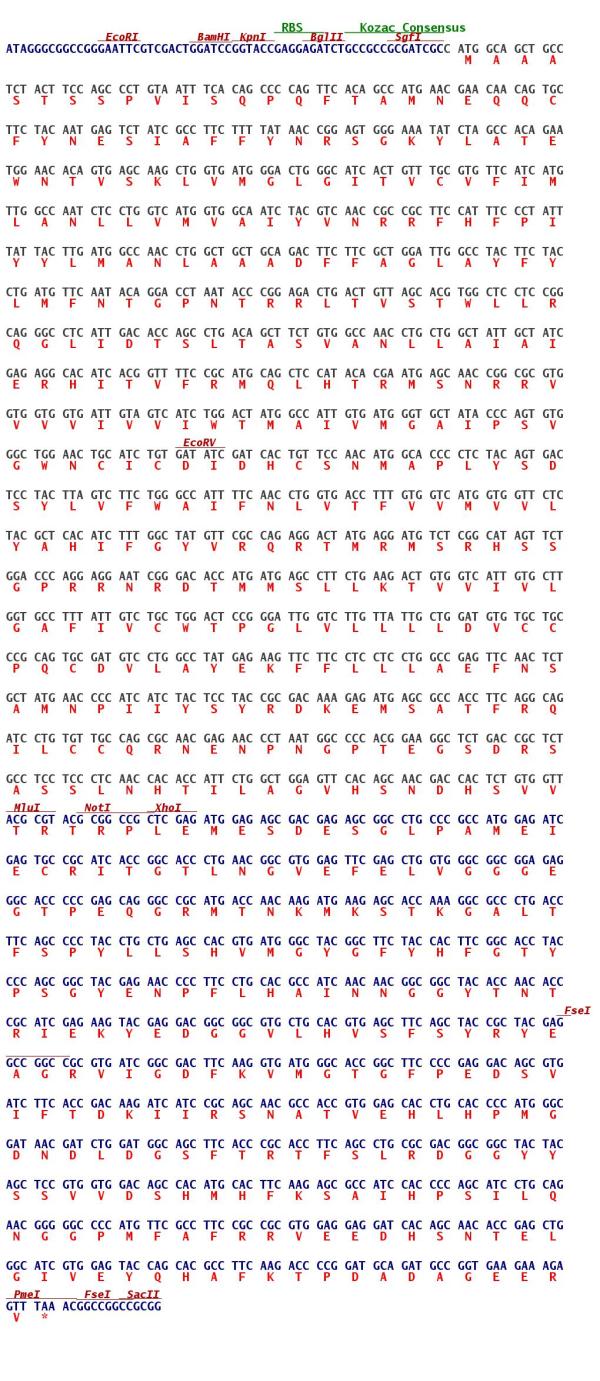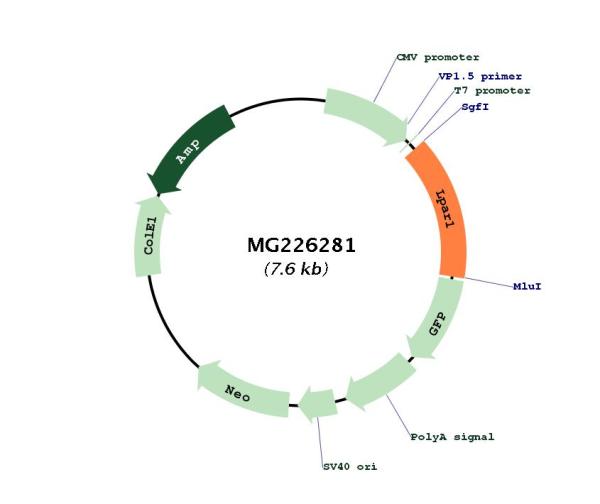Lpar1 (NM_010336) Mouse Tagged ORF Clone
SKU
MG226281
Lpar1 (tGFP-tagged) - Mouse lysophosphatidic acid receptor 1 (Lpar1) transcript variant 1, (10ug)
-
TrueORF®
TrueORF®
Expression-ready ORF plasmid with C-terminal tag(s)
Click here to learn more.
| Product Data | |
| Type | Mouse Tagged ORF Clone |
|---|---|
| Target Symbol | Lpar1 |
| Synonyms | AI326300; Edg2; Gpcr26; Kdt2; lpA1; vzg-1 |
| Vector | pCMV6-AC-GFP |
| E. coli Selection | Ampicillin (100 ug/mL) |
| Mammalian Cell Selection | Neomycin |
| Sequence Data |
ORF Nucleotide Sequence
>MG226281 representing NM_010336
Red=Cloning site Blue=ORF Green=Tags(s) TTTTGTAATACGACTCACTATAGGGCGGCCGGGAATTCGTCGACTGGATCCGGTACCGAGGAGATCTGCC GCCGCGATCGCC ATGGCAGCTGCCTCTACTTCCAGCCCTGTAATTTCACAGCCCCAGTTCACAGCCATGAACGAACAACAGT GCTTCTACAATGAGTCTATCGCCTTCTTTTATAACCGGAGTGGGAAATATCTAGCCACAGAATGGAACAC AGTGAGCAAGCTGGTGATGGGACTGGGCATCACTGTTTGCGTGTTCATCATGTTGGCCAATCTCCTGGTC ATGGTGGCAATCTACGTCAACCGCCGCTTCCATTTCCCTATTTATTACTTGATGGCCAACCTGGCTGCTG CAGACTTCTTCGCTGGATTGGCCTACTTCTACCTGATGTTCAATACAGGACCTAATACCCGGAGACTGAC TGTTAGCACGTGGCTCCTCCGGCAGGGCCTCATTGACACCAGCCTGACAGCTTCTGTGGCCAACCTGCTG GCTATTGCTATCGAGAGGCACATCACGGTTTTCCGCATGCAGCTCCATACACGAATGAGCAACCGGCGCG TGGTGGTGGTGATTGTAGTCATCTGGACTATGGCCATTGTGATGGGTGCTATACCCAGTGTGGGCTGGAA CTGCATCTGTGATATCGATCACTGTTCCAACATGGCACCCCTCTACAGTGACTCCTACTTAGTCTTCTGG GCCATTTTCAACCTGGTGACCTTTGTGGTCATGGTGGTTCTCTACGCTCACATCTTTGGCTATGTTCGCC AGAGGACTATGAGGATGTCTCGGCATAGTTCTGGACCCAGGAGGAATCGGGACACCATGATGAGCCTTCT GAAGACTGTGGTCATTGTGCTTGGTGCCTTTATTGTCTGCTGGACTCCGGGATTGGTCTTGTTATTGCTG GATGTGTGCTGCCCGCAGTGCGATGTCCTGGCCTATGAGAAGTTCTTCCTCCTCCTGGCCGAGTTCAACT CTGCTATGAACCCCATCATCTACTCCTACCGCGACAAAGAGATGAGCGCCACCTTCAGGCAGATCCTGTG TTGCCAGCGCAACGAGAACCCTAATGGCCCCACGGAAGGCTCTGACCGCTCTGCCTCCTCCCTCAACCAC ACCATTCTGGCTGGAGTTCACAGCAACGACCACTCTGTGGTT ACGCGTACGCGGCCGCTCGAG - GFP Tag - GTTTAA
Protein Sequence
>MG226281 representing NM_010336
Red=Cloning site Green=Tags(s) MAAASTSSPVISQPQFTAMNEQQCFYNESIAFFYNRSGKYLATEWNTVSKLVMGLGITVCVFIMLANLLV MVAIYVNRRFHFPIYYLMANLAAADFFAGLAYFYLMFNTGPNTRRLTVSTWLLRQGLIDTSLTASVANLL AIAIERHITVFRMQLHTRMSNRRVVVVIVVIWTMAIVMGAIPSVGWNCICDIDHCSNMAPLYSDSYLVFW AIFNLVTFVVMVVLYAHIFGYVRQRTMRMSRHSSGPRRNRDTMMSLLKTVVIVLGAFIVCWTPGLVLLLL DVCCPQCDVLAYEKFFLLLAEFNSAMNPIIYSYRDKEMSATFRQILCCQRNENPNGPTEGSDRSASSLNH TILAGVHSNDHSVV TRTRPLE - GFP Tag - V |
| Chromatograms |
Chromatograms
 Sequencher program is needed, download here |
| Restriction Sites |
SgfI-MluI Cloning Scheme for this gene
Plasmid Map

|
| ACCN | NM_010336 |
| ORF Size | 1092 bp |
| OTI Disclaimer | Due to the inherent nature of this plasmid, standard methods to replicate additional amounts of DNA in E. coli are highly likely to result in mutations and/or rearrangements. Therefore, OriGene does not guarantee the capability to replicate this plasmid DNA. Additional amounts of DNA can be purchased from OriGene with batch-specific, full-sequence verification at a reduced cost. Please contact our customer care team at custsupport@origene.com or by calling 301.340.3188 option 3 for pricing and delivery. The molecular sequence of this clone aligns with the gene accession number as a point of reference only. However, individual transcript sequences of the same gene can differ through naturally occurring variations (e.g. polymorphisms), each with its own valid existence. This clone is substantially in agreement with the reference, but a complete review of all prevailing variants is recommended prior to use. More info |
| OTI Annotation | This clone was engineered to express the complete ORF with an expression tag. Expression varies depending on the nature of the gene. |
| Components | The ORF clone is ion-exchange column purified and shipped in a 2D barcoded Matrix tube containing 10ug of transfection-ready, dried plasmid DNA (reconstitute with 100 ul of water). |
| Reconstitution Method | 1. Centrifuge at 5,000xg for 5min. 2. Carefully open the tube and add 100ul of sterile water to dissolve the DNA. 3. Close the tube and incubate for 10 minutes at room temperature. 4. Briefly vortex the tube and then do a quick spin (less than 5000xg) to concentrate the liquid at the bottom. 5. Store the suspended plasmid at -20°C. The DNA is stable for at least one year from date of shipping when stored at -20°C. |
| Note | Plasmids are not sterile. For experiments where strict sterility is required, filtration with 0.22um filter is required. |
| Shipping | Ambient |
| Reference Data | |
| RefSeq | NM_010336.2, NP_034466.2 |
| RefSeq Size | 3362 bp |
| RefSeq ORF | 1095 bp |
| Locus ID | 14745 |
| UniProt ID | P61793 |
| Cytogenetics | 4 32.2 cM |
| Summary | Receptor for lysophosphatidic acid (LPA) (PubMed:11087877, PubMed:18066075). Plays a role in the reorganization of the actin cytoskeleton, cell migration, differentiation and proliferation, and thereby contributes to the responses to tissue damage and infectious agents. Activates downstream signaling cascades via the G(i)/G(o), G(12)/G(13), and G(q) families of heteromeric G proteins (PubMed:8922387, PubMed:9600933, PubMed:11040035, PubMed:18157949, PubMed:18066075, PubMed:23478264). Signaling inhibits adenylyl cyclase activity and decreases cellular cAMP levels (PubMed:11040035, PubMed:12215548). Signaling triggers an increase of cytoplasmic Ca(2+) levels (PubMed:12215548). Activates RALA; this leads to the activation of phospholipase C (PLC) and the formation of inositol 1,4,5-trisphosphate (PubMed:11040035, PubMed:12215548, PubMed:23478264). Signaling mediates activation of down-stream MAP kinases (PubMed:11040035). Contributes to the regulation of cell shape (PubMed:8922387, PubMed:9600933, PubMed:11040035, PubMed:11087877). Promotes Rho-dependent reorganization of the actin cytoskeleton in neuronal cells and neurite retraction (PubMed:9600933, PubMed:11040035, PubMed:12181339). Promotes the activation of Rho and the formation of actin stress fibers (PubMed:9600933, PubMed:12215548). Promotes formation of lamellipodia at the leading edge of migrating cells via activation of RAC1 (PubMed:23478264). Through its function as lysophosphatidic acid receptor, plays a role in chemotaxis and cell migration, including responses to injury and wounding (PubMed:11087877, PubMed:18066075, PubMed:23478264). Plays a role in triggering inflammation in response to bacterial lipopolysaccharide (LPS) via its interaction with CD14 (PubMed:21821728). Promotes cell proliferation in response to lysophosphatidic acid (PubMed:9600933, PubMed:11087877, PubMed:12215548, PubMed:18157949, PubMed:17692995, PubMed:23478264). Required for normal skeleton development (PubMed:21569876). May play a role in osteoblast differentiation (PubMed:21569876). Required for normal brain development (PubMed:17656621, PubMed:18708146). Required for normal proliferation, survival and maturation of newly formed neurons in the adult dentate gyrus (PubMed:18708146). Plays a role in pain perception and in the initiation of neuropathic pain (PubMed:15195086, PubMed:19689455).[UniProtKB/Swiss-Prot Function] |
Write Your Own Review
| Product Manuals |
| FAQs |
| SDS |
| SKU | Description | Size | Price | |
|---|---|---|---|---|
| MC202097 | Lpar1 (untagged) - Mouse lysophosphatidic acid receptor 1 (Lpar1), transcript variant 1, (10ug) | 10 ug |
$686.00
|
|
| MG205601 | Lpar1 (tGFP-tagged) - Mouse endothelial differentiation, lysophosphatidic acid G-protein-coupled receptor, 2 (Edg2) | 10 ug |
$886.00
|
|
| MR226281 | Lpar1 (Myc-DDK-tagged) - Mouse lysophosphatidic acid receptor 1 (Lpar1), transcript variant 1 | 10 ug |
$686.00
|
|
| MR226281L3 | Lenti ORF clone of Lpar1 (Myc-DDK-tagged) - Mouse lysophosphatidic acid receptor 1 (Lpar1), transcript variant 1 | 10 ug |
$986.00
|
|
| MR226281L4 | Lenti ORF clone of Lpar1 (mGFP-tagged) - Mouse lysophosphatidic acid receptor 1 (Lpar1), transcript variant 1 | 10 ug |
$986.00
|
|
Citations
*Delivery time may vary from web posted schedule. Occasional delays may occur due to unforeseen
complexities in the preparation of your product. International customers may expect an additional 1-2 weeks
in shipping.







